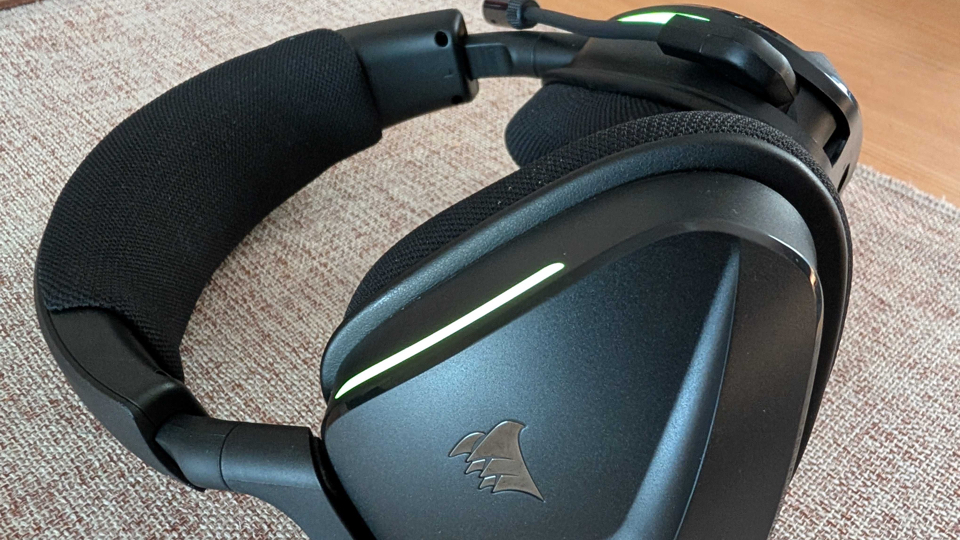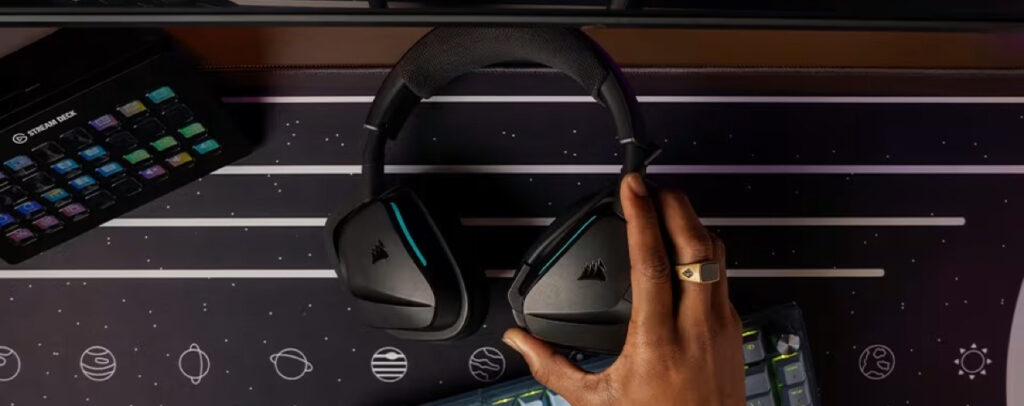Corsair make a whole heap of peripherals. From PC cases with RGB lighting to keyboards with RGB lighting, and even headsets… with RGB lighting. What I’m saying is, they have a thing for rainbow light effects, and with their brand-new Void Wireless V2 headset, that trend is set to continue.
Corsair’s headsets have their own distinctive design language, eschewing ovals, circles and rectangles in favour of less regular rounded trapeziums. They could be inspired by sails, perhaps even by tricorn hats, either of which would make sense if you know anything about corsairs.
Here, that gives us a sleek black headset, which on first impression looks pretty understated, but when powered up they come alive thanks to two RGB strips down the side of each earpiece. It isn’t overpowering, especially compared to some other headsets, but it gives the Void Wireless V2 a unique look that’s well worth checking in for.
It’s also comfortable. Thanks to the Void V2’s mere 296g of weight, it goes very easy on your head and ears, helped by the plush fabric-covered ear cushions and thick padded headband. The only oddity for me was that its earcups don’t seem to want to fit entirely flat against the side of my head. I think this is partly because I have a slightly smaller head – and no hair to provide natural cushioning – and the feeling has lessened as I’ve spent longer using it, but it’s worth considering if you’ve got a smaller cranium. That also means there’s definitely more audio-bleed from outside, and the Void Wireless V2 has the lowest passive noise cancellation I’ve found in a while, whether the earpieces are entirely flat or not.
Connection comes via both Bluetooth and a sizeable 2.4Ghz USB-A wireless dongle, sticking way out of the front of your PS5 quite obviously if you’re not using a rear port. The advantage to that is it’s less likely to get lost, and since I’ve had various instances of wireless dongles disappearing, never to be found again, I’ll take it. The Void Wireless V2 doesn’t just work with PS5, as PC, Mac, PS4, Switch and Mobile are all covered by this pair of connection options.
The Void V2 opts for simplicity when it comes to controls, with a power button nestled next to the customisable multifunction button on the left earpiece. Over here, there’s also the volume toggle wheel, and it’s a slightly odd control, flicking up or down to change the volume, or pressing it in to alter the EQ setting. It’s solid enough, and the spring-loaded action makes using it feel suitably precise, but there’s something about it that I’m just not that keen on.
Besides that, there’s the omnidirectional microphone arm, automatically muted when flipped up, and on when angled down. There’s a great level of customisation here, with a metallic boom arm that moves exactly where you want it to, contorting and angling as you’d hope. When so many manufacturers are opting for solid, one-piece mic arms, it’s a welcome inclusion.
Charging is via a USB-C port, and you won’t have to reach for the included 1.8m charging cable all that often, with a maximum of 65 hours of playtime, if you’re using the wireless dongle and you’ve turned the RGB off. Even with the RGB on, it sips away at the battery, and it’s almost a surprise when it runs out, making the Void V2 very easy to live with.

The Void Wireless V2’s 50mm drivers have plenty of oomph – that’s a technical term – and their ability to shift air around is probably more than most ears can take. The standard EQ setting is surprisingly flat, and I wasn’t expecting to find a more understated bass response compared to peers like the Turtle Beach Stealth 500, especially considering the larger drivers.
I’ve been playing a spot of Fragpunk on PS5, and here the Void Wireless V2 didn’t sell itself incredibly well, with the standard EQ settings making for gunplay which sounds indefinite and muddy. No matter which EQ setting you’re using, the out-of-the-box response is too heavy on the mids, making the overall experience woolly. There are 4 EQ presets to choose from, but outside of the top-end focused FPS mode, they all perform fairly similarly. It’s a real shame, but there is something you can do about it.
You’ll need to use the iCUE software to get the most out of the Void Wireless V2, but it’s only available for PC and Mac. If you’re a console player, then you’re going to have to live with the standard, out-of-the-box experience, which isn’t particularly strong.

Utilising iCUE, you get access to saved profiles, custom EQs and the ability to update and alter your headset’s microphone performance. If you’ve got a compatible Nvidia card, you can also add Nvidia Studio to help block out further unwanted background noise from your microphone, all of which makes for a really compelling package. There’s none of that if you’re playing on console, though.
With the ability to tweak your EQ, the Void Wireless V2 comes to life. There’s great incremental control via the 10-band EQ, and listening to some of my favourite music like Dinosaur Pile-up and Bring Me The Horizon showcases that the Void V2 can be a great-sounding headset.
Similarly, diving into Elden Ring: Nightreign on PC, the Void V2 proved thoroughly brilliant, with plenty of detail in the top end, and the epic soundtrack dispensed with a suitable level of drama. None of this exists in the out-of-the-box experience, and you can’t save your EQ settings to take back to console, with only lighting settings able to be carried over, which seems like a huge oversight.
At £99.99, the Void Wireless V2 enters a very competitive area, and I’d choose the RIG 600 Pro HS over this every day of the week, with similar high comfort levels, but a far better audio response across the board. The Turtle Beach Stealth 500 is also a stronger choice, with more subdued looks that won’t look too out of place if you leave the house.


